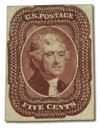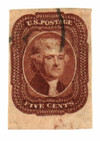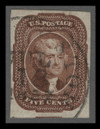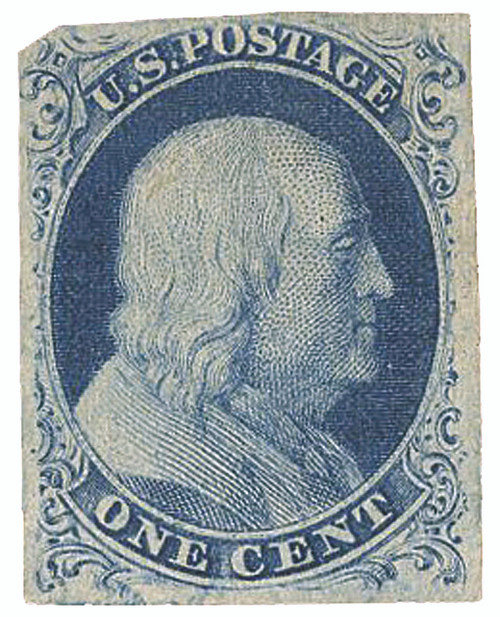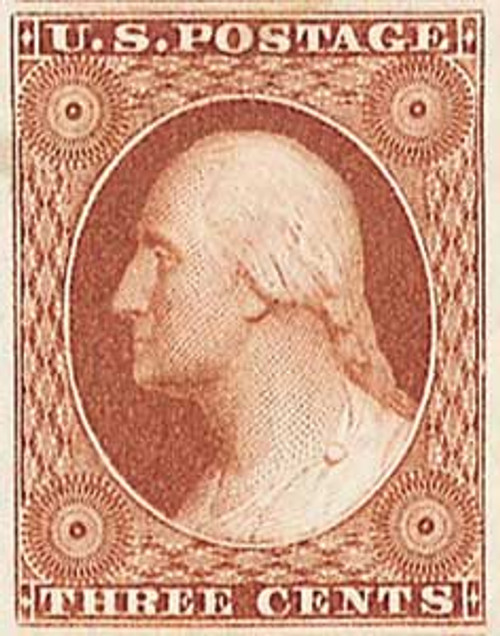
# 12 - 1856 5c Jefferson, red brown, type I, imperforate
U.S. #12
1856 Jefferson, Type I
- First US postage stamp to feature a Founding Father other than Washington or Franklin
- Main usage for paying domestic portion of postage rate on overseas mail going through Britain (British Open Mail rate)
- Single examples of #12 are not often seen on cover
Stamp Category: Definitive
Series: 1851-57 Issue
Value: 5c
Earliest known Use: March 14, 1856
Printed by: Toppan, Carpenter, Casilear & Co.
Quantity printed: 150,000 (estimate)
Format: Printed in sheets of 200 stamps, divided into panes of 100 each
Printing Method: Engraving
Perforations: Imperforate
Color: Red brown
Why the stamp was issued: The 5c Jefferson stamp was likely intended for the prepayment of the registry fee for high-value letters, but was not officially used for that purpose. It did pay the domestic postage portion for letters going to a foreign country if that mail was carried by British packet boats for transport. (Fees for shipping and land transport were paid by the recipient when the letter reached him or her at its destination.) Also commonly used in threes to pay postage to France or as a make-up rate in addition to the 10c value.
About the printing: The design is engraved on a die – a small, flat piece of steel. The design is copied to a transfer roll – a blank roll of steel. Several impressions or “reliefs” are made on the roll. The reliefs are transferred to the plate – a large, flat piece of steel from which the stamps are printed.
Types or “varieties” occur when a stamp has differences which vary from the way it was originally engraved. Foreign matter, or damage to or recutting of the plate, can cause these differences to show up on the stamps printed from it. Color varieties may also be created when a change is made to the printing ink.
About the design: Thomas Jefferson’s portrait on the #12 is based on a painting by Gilbert Stuart, who also painted many portraits of George Washington.
Special Design Details: US #12 is Type I. The projections on all four sides of the stamp are complete.
Later recutting of the engraving plates led to the top and bottom projections being partly cut away on perforated issues of the same design (US #30 and #30A, both type II.)
About the 1851-57 Series: On July 1, 1851, 1c, 3c, and 12c stamps were issued. These new stamps met the reduced postal rates passed by act of Congress on March 3, 1851. U.S. #1 and #2 were demonetized. Later changes due to the Act of March 3, 1855 led to 10c (1855) and 5c (1856) additions to the series. Perforated stamps of the same designs (plus three new designs) were issued in 1857 as part of the Series of 1857-61.
History the stamp represents: America’s first two postage stamps were issued in 1847. Rates were determined by the weight and distance the letter was mailed. Letters mailed 300 miles or less were 5¢ per half ounce; while those mailed over 300 miles were 10¢ per half ounce. Postage could be paid by the sender at the time the letter was mailed, or by the addressee upon receipt.
US#1 and #2 and the fees they paid remained in use until 1851, when Congress reduced postal rates. These new rates created the need for new denominations. The first stamps issued to meet the lower rates were issued on July 1, 1851. The new 1¢ stamp was used on newspapers, circulars, and “drop letters” (letters mailed to the same town.) The single letter rate, based on a half-ounce, was changed to 3¢ for mail sent up to and including 3,000 miles (except for drop letters.) Mail exceeding this distance was lowered to 6¢ and two of the new 3c stamps could be used to pay postage to the West Coast. Besides the 1c and 3c stamps, a 12c stamp was issued.
An Act of Congress on March 3rd, 1855 made the pre-payment of postage mandatory as of January 1st, 1856. Requiring people to use stamps lightened the burden on postal clerks and allowed mailers to simply drop their letters in the post office mail slot, rather than waiting in long lines. Americans appreciated the cheaper rates as well.
U.S. #12
1856 Jefferson, Type I
- First US postage stamp to feature a Founding Father other than Washington or Franklin
- Main usage for paying domestic portion of postage rate on overseas mail going through Britain (British Open Mail rate)
- Single examples of #12 are not often seen on cover
Stamp Category: Definitive
Series: 1851-57 Issue
Value: 5c
Earliest known Use: March 14, 1856
Printed by: Toppan, Carpenter, Casilear & Co.
Quantity printed: 150,000 (estimate)
Format: Printed in sheets of 200 stamps, divided into panes of 100 each
Printing Method: Engraving
Perforations: Imperforate
Color: Red brown
Why the stamp was issued: The 5c Jefferson stamp was likely intended for the prepayment of the registry fee for high-value letters, but was not officially used for that purpose. It did pay the domestic postage portion for letters going to a foreign country if that mail was carried by British packet boats for transport. (Fees for shipping and land transport were paid by the recipient when the letter reached him or her at its destination.) Also commonly used in threes to pay postage to France or as a make-up rate in addition to the 10c value.
About the printing: The design is engraved on a die – a small, flat piece of steel. The design is copied to a transfer roll – a blank roll of steel. Several impressions or “reliefs” are made on the roll. The reliefs are transferred to the plate – a large, flat piece of steel from which the stamps are printed.
Types or “varieties” occur when a stamp has differences which vary from the way it was originally engraved. Foreign matter, or damage to or recutting of the plate, can cause these differences to show up on the stamps printed from it. Color varieties may also be created when a change is made to the printing ink.
About the design: Thomas Jefferson’s portrait on the #12 is based on a painting by Gilbert Stuart, who also painted many portraits of George Washington.
Special Design Details: US #12 is Type I. The projections on all four sides of the stamp are complete.
Later recutting of the engraving plates led to the top and bottom projections being partly cut away on perforated issues of the same design (US #30 and #30A, both type II.)
About the 1851-57 Series: On July 1, 1851, 1c, 3c, and 12c stamps were issued. These new stamps met the reduced postal rates passed by act of Congress on March 3, 1851. U.S. #1 and #2 were demonetized. Later changes due to the Act of March 3, 1855 led to 10c (1855) and 5c (1856) additions to the series. Perforated stamps of the same designs (plus three new designs) were issued in 1857 as part of the Series of 1857-61.
History the stamp represents: America’s first two postage stamps were issued in 1847. Rates were determined by the weight and distance the letter was mailed. Letters mailed 300 miles or less were 5¢ per half ounce; while those mailed over 300 miles were 10¢ per half ounce. Postage could be paid by the sender at the time the letter was mailed, or by the addressee upon receipt.
US#1 and #2 and the fees they paid remained in use until 1851, when Congress reduced postal rates. These new rates created the need for new denominations. The first stamps issued to meet the lower rates were issued on July 1, 1851. The new 1¢ stamp was used on newspapers, circulars, and “drop letters” (letters mailed to the same town.) The single letter rate, based on a half-ounce, was changed to 3¢ for mail sent up to and including 3,000 miles (except for drop letters.) Mail exceeding this distance was lowered to 6¢ and two of the new 3c stamps could be used to pay postage to the West Coast. Besides the 1c and 3c stamps, a 12c stamp was issued.
An Act of Congress on March 3rd, 1855 made the pre-payment of postage mandatory as of January 1st, 1856. Requiring people to use stamps lightened the burden on postal clerks and allowed mailers to simply drop their letters in the post office mail slot, rather than waiting in long lines. Americans appreciated the cheaper rates as well.




